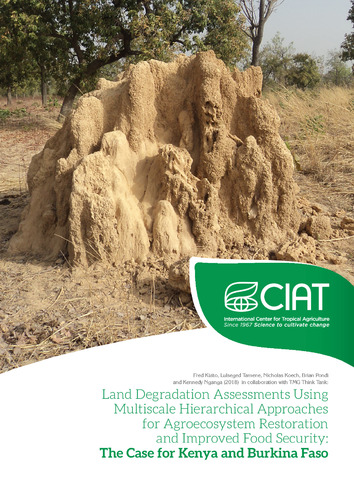Land Degradation Assessments Using Multiscale Hierarchical Approaches for Agroecosystem Restoration and Improved Food Security: The Case for Kenya and Burkina Faso
This report provides a synthesis on land degradation assessments conducted for two countries (Kenya and
Burkina Faso) at different scales. The task mainly involved identifying hotspot areas of degradation that require priority management interventions. The approach involves modelling, stakeholder engagement and field validation.
In the report, we refer to land degradation as the persistent loss of ecosystem function and productivity caused by disturbances from which the land cannot recover unaided.
Hotspots refer to places that, if left unattended, could prove harmful, both to the environment and to those dependent on it. These areas generally require priority management interventions due to the severity of the degradation problem and its associated cost. Considering the fact that land degradation processes differ across space and over time and that there will be no ‘one-size-fitsall’ approach to assess the severity of the problem and its spatial distribution, a multiscale hierarchical approach was followed. At the national level, we used time series satellite and rainfall data to trace the spatial distribution of land degradation and identify the major drivers (human caused versus climate induced). Results from such exercise would benefit national level planning and decision making. In addition, development organizations, donors and NGOs can benefit from such results to target their interventions. At the county/province/district level, we developed an ‘index’ that can help map land degradation risks using relatively higher resolution data. Such products can be beneficial to county/district level planners as well as stakeholders whose activities are relevant to this scale. The third and more detailed level of analysis employs a spatially distributed hydrological model to map land degradation hotspots at landscape and/or farm levels and assess the impacts of land management options. Outputs from this analysis can be used by development agents, extension workers as well as local communities and farmers to facilitate targeted decision making. The above sequential steps clearly demonstrate the need for context-specific analysis that fit to local and regional conditions. In addition to the modelling and analysis results, the report provides recommendations for farmers, policy makers, decision and development agents and researchers regarding the implications of the land degradation findings towards identifying technical, policy and institutional arrangements that will promote land restoration, agroecosystem health and food security in order to meet current and future human and environmental sustainability objectives.

